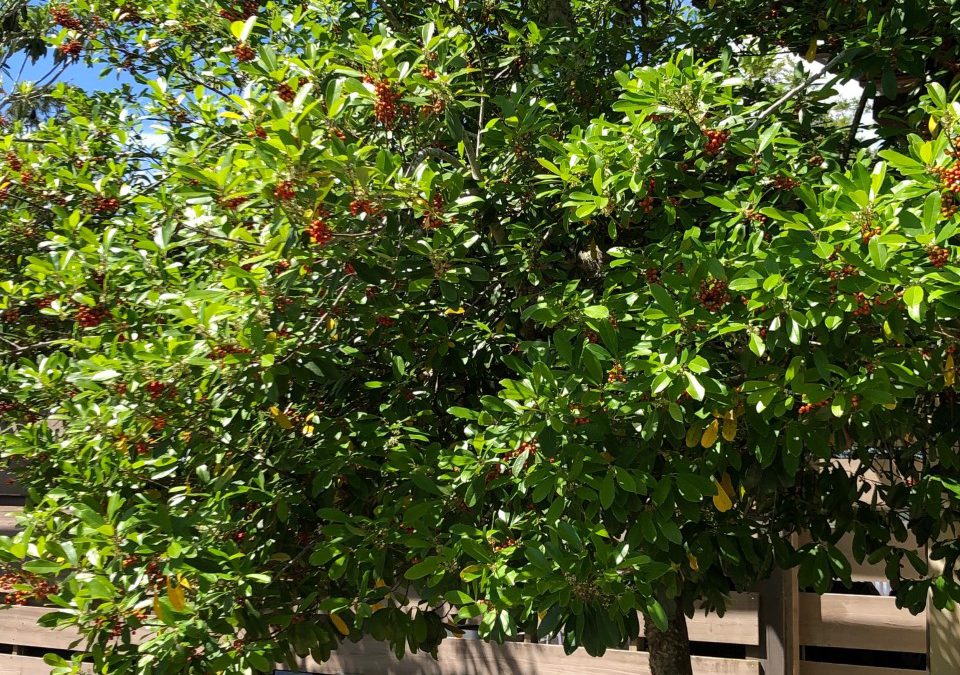
by Stephen Greer | Jun 29, 2022
There are many considerations to make when landscaping with small trees (under 20 feet) in the landscape that are not suitable for large trees. Some of the trees discussed can at times be considered large shrubs depending on definitions and opinions. For the purpose of this article, if it reaches 15 to 20 feet consider it a tree.
Choosing small trees for the right setting involves a number of reasons that could include the need for more privacy from other homes, use as a sound barrier from busy roads, hiding your utility area of the landscape or something unattractive nearby and making sure power lines are not obstructed. Other considerations might include soil types, drainage and holding capacity of the soils, irrigation needs, rate of plant growth and maturity height at 20 feet. Below are a few to consider for the Panhandle of Florida.
Little Gem Magnolia (Magnolia grandiflora ‘Little Gem’) and Teddy Bear Magnolia (M. grandiflora ‘Teddy Bear’) are strong hardy plants once established (within the first 6 months to a year). Both are evergreen with dark green foliage. The ‘Little Gem’ will grow to 20 feet tall by 15 to 18 feet wide. As it matures it tends to become more open and less dense which adds a nice character to show parts of the lower limbs. The ‘Teddy Bear’ will grow to 18 to 20 feet tall but at an even slower rate of maturity to 12 to 15 feet wide while maintaining its density of foliage from bottom to top. It may take a little work to locate the ‘Teddy Bear’ Magnolia.
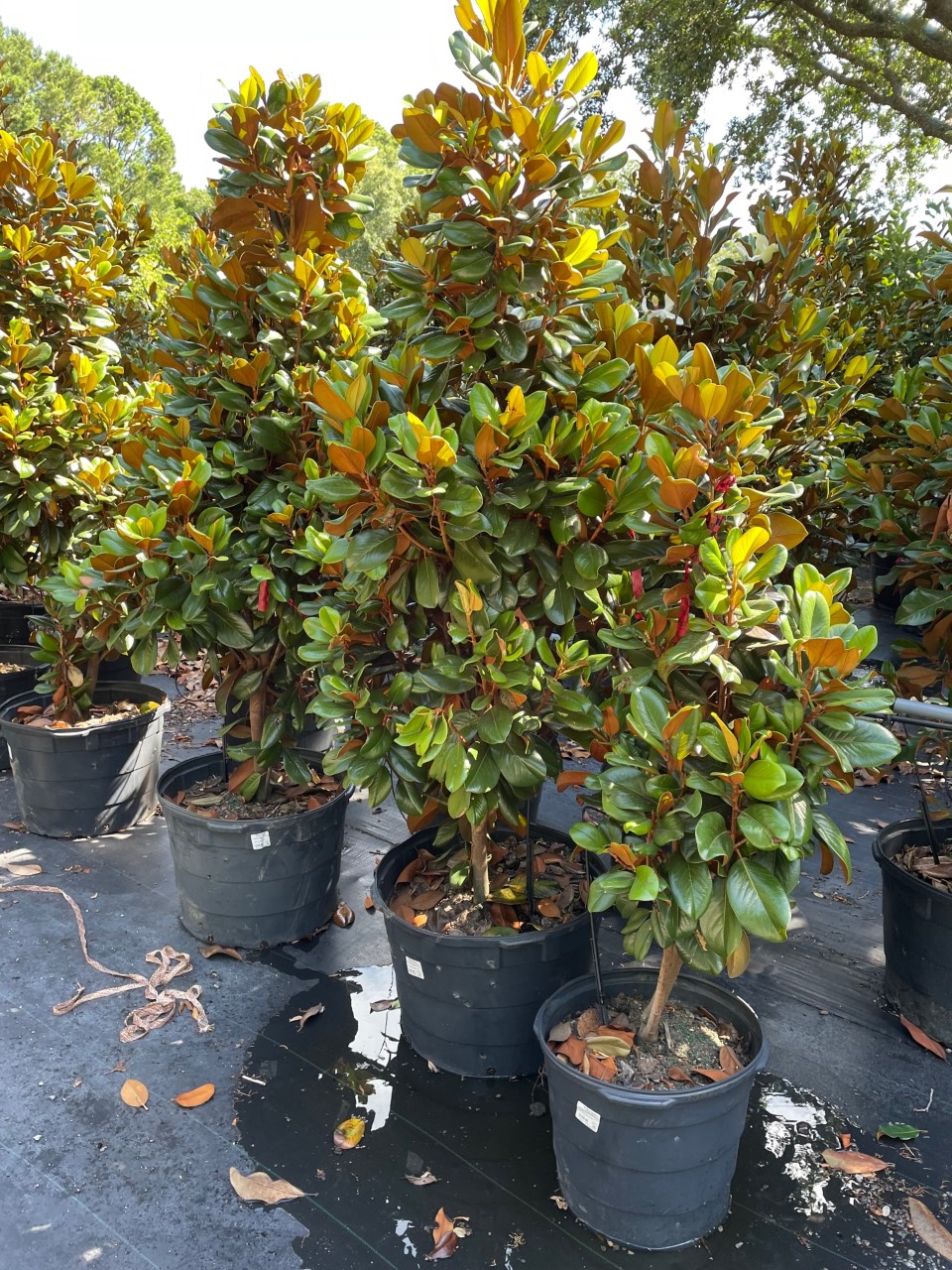
Photo courtesy: Stephen Greer Teddy Bear Magnolia (Small compact grower)
Several hollies to consider would include the Cassine Holly ‘Tensaw’ (Ilex cassine ‘Tensaw’) and American Holly (Ilex opaca). Both are evergreen and produce red berries during the fall that are bird favorites. They have similar heights of 15 to 20 feet and widths of 10 to 12 feet. Pruning can assist in shaping and slowing these measurements, but keep in mind this will change the look of the tree and create a more formal plant presentation.
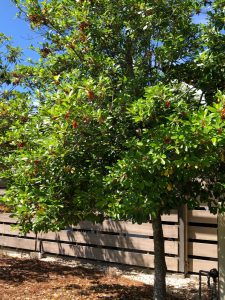
Photo courtesy: Stephen Greer Cassine Holly ‘Tensaw’
The Fringe Tree (Chionanthus virginica) has been a popular tree southeast U.S. for many years. It brings a bright spot to the landscape with white flower panicles that cover the tree in mid to late spring depending on location. For a full color effect, plant it with an evergreen hedge behind it. This oval deciduous tree will grow to 12 to 20 by 10 to 15 wide. The dark blue fruit appears in the fall and serves as good bird food source. This fruit is usually hidden behind the foliage. There might even be a nice yellow leaf change in the fall if temperatures and weather allow.
There are so many more trees to discuss and limited space to discuss them. Visit your local UF IFAS Extension office for additional assistance or visit the UF IFAS online for additional articles.
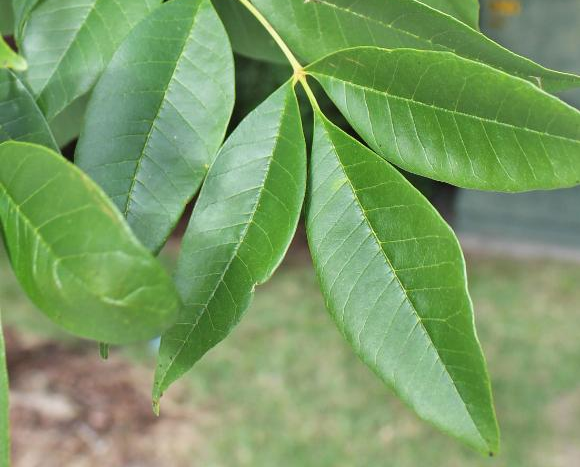
by Daniel J. Leonard | Jun 2, 2022
The Oracle of Omaha, Warren Buffett, once said “Someone is sitting in the shade today because someone planted a tree long ago.” While that’s all fine and good and I’m happy that the next generation gets to enjoy the things we grew, most of us would like to enjoy shade in our lifetimes too! If you too want to plant your own shade, one of the best rapidly growing shade tree choices for the Panhandle is the majestic Florida native Green Ash (Fraxinus pennsylvanica).
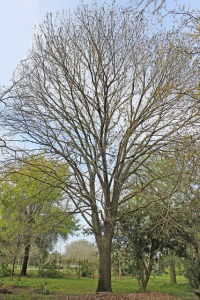
Green ash trees have a vase shape form. Photo Credit: University of Florida/IFAS
Green Ash is a large (50-100’ tall), oval-shaped, deciduous shade tree native to the entire eastern half of North America, but best of all for those of us craving shade, it grows to its mature height in a relative hurry. While most trees that grow extremely fast tend to be inherently weak and short-lived, this is not the case with Green Ash. Capable of growing 6-10’ in a single year if irrigated and fertilized appropriately and often living well over 100 years, there aren’t many plants in the Panhandle that grow quicker or live longer.
There’s much more to Green Ash than growth rate and life span, however. The tree is also one of the prettiest around. Come on, you didn’t think I’d recommend an ugly plant, did you? A look up into the canopy at different times of the year and one can see the tree’s deep, dark green foliage, good-for-Florida yellowish fall color, and slightly showy light green seed pods. Below, the straight trunk is laced with distinctive diamond-shaped bark that hints at the extremely high-quality wood underneath. Fun fact, Ash is historically the most popular wood used to make baseball bats due to its hardness at a relatively light weight – more MLB home runs have been hit with Ash than any other species!
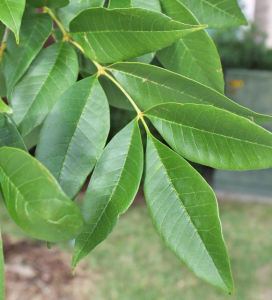
The compound leaf of a green ash tree. Photo Credit: University of Florida/IFAS
As a Florida-Friendly plant, Green Ash is fairly low-maintenance and provides many environmental services. The species, like any other plant, requires supplemental water and fertilizer during the establishment period, generally the first year or so after planting, but doesn’t demand much else from gardeners after that. Green Ash specimens in Florida also don’t have much in the way of pest problems (the invasive Emerald Ash Borer has devastated ash populations in northern states but thankfully has not yet been found in Florida). However, as a host plant for several native pollinators, including the Eastern Tiger Swallowtail, Mourning Cloak, Orange Sulphur, and Viceroy Butterflies, you may occasionally find caterpillars munching away on the tree’s foliage. If you can handle a little leaf damage, try to leave any caterpillars alone and enjoy the stunning butterflies they later morph into!
Green Ash is a beautiful, ultra-adaptable shade tree. Though the species prefers moist areas, there aren’t many sites the tree can’t thrive in. Do you have a low-lying area near a swamp or stream that stands in water from time to time? Great! Green Ash will thrive. Do you need a street tree to survive in a harsh environment with a cramped root zone surrounded by concrete? Green Ash will be right at home there as well. Green Ash is simply a classic shade tree with many interesting attributes that improves the look of any landscape it occupies. Plant one today!
For more information about Green Ash, other shade tree species, or any other horticultural/agricultural topic, contact us at the UF/IFAS Calhoun County Extension office.

by Ashley Stonecipher | May 26, 2022
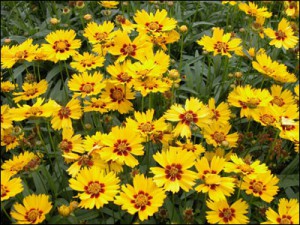
Coreopsis flowers. Photo courtesy UF/IFAS.
A beautiful wildflower that lines the roads and open areas is one of my favorite native pollinating plants. Coreopsis also commonly known as Tickseed was designated our Florida State Wildflower in 1991. It can be found throughout Florida and all 17 species occur in North Florida. Varieties such as Leavenworth’s Swamp (C.nudata), Florida (C. floridana) and Coastalplain (C. gladiata) are found in moist areas and other varieties like Lanceleaf Tickseed (C. lanceolata) and Goldenmane Tickseed (C. basalis) are commonly found in the drier areas of the landscape.
All the varieties of Tickseeds have daisy-like flowers with yellow petals except for the Swamp Tickseed which is more pinkish purple in color. The flower gets its common name by the appearance of the small ovalish seed that has two short spines at one end and looks like a ‘tick’. The most common coreopsis is Coreopsis leavenworthii. This plant can be found in moist pinelands and disturbed sites. You can spot the blooms of bright yellow ray petals with brownish central disk flowers from late spring through late fall. This coreopsis can reach 3 feet in height. It grows like a weed and can quickly establish itself on bare soil. Coreopsis is essentially an annual with our colder winters but produces many seeds that will multiply as long as the plant receives adequate sun and moisture. A special species of coreopsis found only here in the Panhandle is the Chipola coreopsis (C. integrifolia). It is less common and only found along the Chipola River. This 18-24” plant has deep green oval-shaped leaves and deep yellow flowers seen blooming in the Fall, maybe a great time to go kayaking or hiking along the river! The Chipola coreopsis prefers moist soils and some protection from the sun. This variety is so rare that it has been listed endangered by the Florida Department of Agriculture.
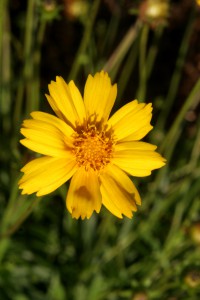
Native Lanceleaf Coreopsis. UF/IFAS Photo: Thomas Wright.
Coreopsis is pollinated mostly by small bees and not visited as much by butterflies and other pollinators. They are a great plant to use for a show of color! You can get seeds from your local garden center or from the Florida Wildflower Growers Cooperative (https://floridawildflowers.com). This Florida-Friendly plant is drought tolerant and can be sown anytime from October to January.
Sources:
https://www.flawildflowers.org/wp-content/resources/pdfs/Publications/AboutCoreopsis.pdf
https://gardeningsolutions.ifas.ufl.edu/plants/ornamentals/coreopsis.html
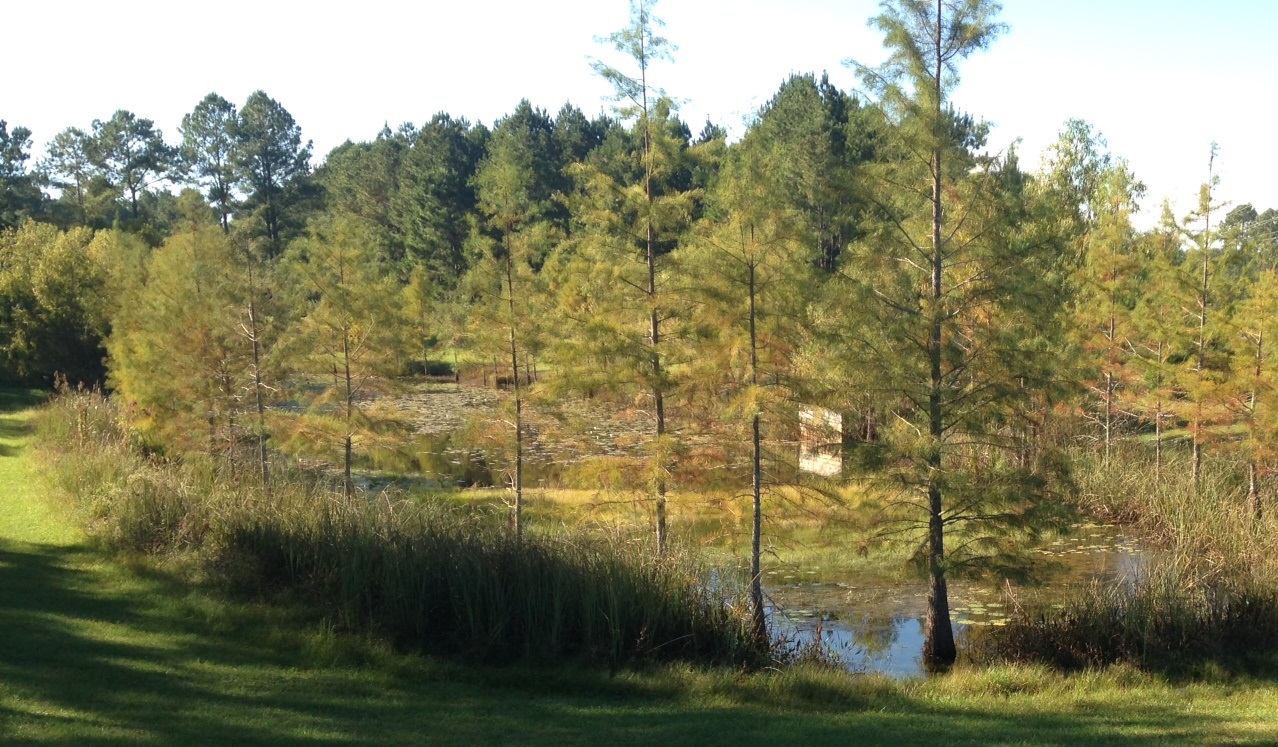
by Ashley Stonecipher | Apr 20, 2022
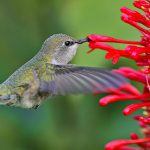
A hummingbird gathering nectar from a firespike (Odontonema strictum) flower. Photo Credit: Knolllandscapindesign.com
Do you enjoy watching a variety of birds and butterflies in your landscape? Have you ever watched squirrels get into the birdfeeder? Children may learn about wildlife by watching through a window. Food, water, cover, and space are four essential elements that will create the best habitat for wildlife. Food could be as simple as adding feeders to attract birds to your yard but having a habitat that sustains them is important. Florida wildlife and Florida native plants evolved together and are often interdependent. It is a must to understand what sustains the species you are wanting to attract to your area. Different species prefer different food/plants. Insects also provide birds a food source for their young.
Water can be bird baths, man-made ponds, and natural bodies of water such as streams, lakes, ponds on your property. When relying on a bird bath for your water supply make sure the water is fresh and clean. Shallow water (1-1.5 inches) is better than deep (over 3 inches). Birds like sloping sides and a textured surface; they prefer to walk into water rather than dive in headfirst. Place the bath 5 to 10 feet from a protective cover like shrubs or trees. This needs to be close enough for the birds to be able to reach safety if there is danger from predators. A small outpost for birds to land on near the bath can help them check for predators before heading to the bath.
Cover will provide a place to raise young and should have vertical layers for animals to use for safety, shelter, and nests. Examples of cover that could be added to the landscape are snags that give food for woodpeckers and nesting perches. Or build your own nesting boxes that are species specific for owls, bees, and bats. All bats eat insects and substantially reduce the number of nocturnal insects in a neighborhood.
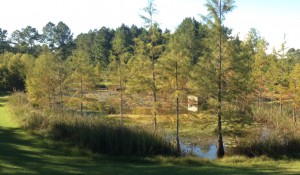
The permanently wet detention pond lined with cypress trees and sawgrass also provides habitat for fish, birds, and reptiles. Photo Credit: Carrie Stevenson, University of Florida/IFAS Extension – Escambia County
Lastly it is important to think of your space. Create large patches of good habitat that span several landscapes or consider working with your neighbors to link the backyard habitats and create a larger area. It is all about the “Right Plant, Right Place” concept and understanding the area you are working with and the possibilities. When you go into the last step of planting and attracting wildlife have a plan and know what you would like to attract. Do your research on what you will need for that wildlife and use your resources, ask your local extension agent for ideas and suggestions!
Many plants in our native landscape provide much of what attracts wildlife and provides them with at least one of the four essential elements. The article “Planting for Wildlife Habitat!” will give you some ideas of plants and trees that do well in the North Florida area and will help to attract the wildlife you desire!
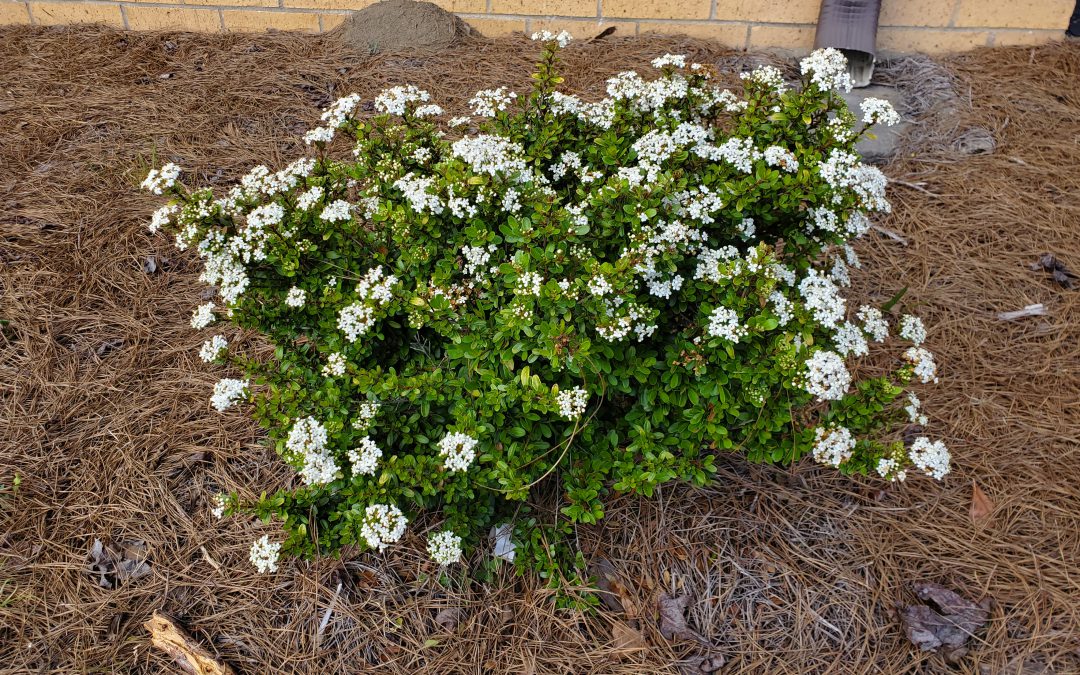
by Daniel J. Leonard | Apr 14, 2022
Lost in the sea of more popular and showy spring-flowering landscape shrubs like azalea, spirea, and the like, is an underused, exceedingly tough, and currently flowering Florida native shrub that is deserving of a spot in your landscape, Walter’s Viburnum (Viburnum obovatum).
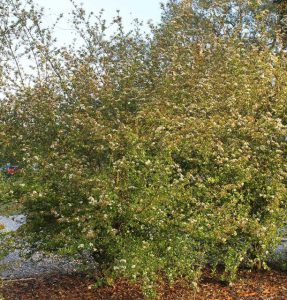
Species Walter’s Viburnum (Viburnum obovatum). Photo Credit: UF/IFAS.
Walter’s Viburnum, named for English-born botanist turned South Carolina farmer Thomas Walter, who first described the species in the late 1700’s, is a spring-flowering mostly evergreen shrub/small tree native to the Southeastern United States. In its native environment around hammocks, swamp edges, and near-river forests beneath the understory of canopy trees, Walter’s specimens often grow to around 15’ in height, live for more than 50 years, and spread slowly into loose thickets from their extensive underground root system. After covering themselves in clusters of small, showy, pollinator-attracting white flowers in spring, Walter’s produces small reddish-black fruit that are magnets for birds and other small wildlife in summer.
Though this tough, low-maintenance nature and gorgeous pure white March flower display should have seemingly enabled Walter’s to be a standout in the landscape, Walter’s Viburnum languished in popularity for many years as it didn’t fit into most landscapes in its wild form. Not too many folks in modern landscape situations are looking for a thicket forming, unkempt-looking tree! However, with increased breeding efforts aimed at selecting superior dwarf varieties and the rise in interest in using low-maintenance native plants, Walter’s has rapidly gained market share on traditional flowering shrubs in nurseries and yards in across Florida.
These newer dwarf varieties of Walter’s, including standouts like ‘Mrs. Schiller’s Delight’ and my personal favorite ‘Whorled Class’, only grow 3-4’ in height and make an excellent replacement for more commonly planted small foundation shrubs. Why plant a disease-prone Boxwood when you can have a disease-resistant native dwarf Walter’s Viburnum? Why allow your landscape to be saddled with drab Dwarf Yaupon Holly when you could get the same basic effect AND an awesome flower show by planting a dwarf Walter’s? Tired of having to constantly prune those Loropetalum or Azaleas to keep them from hiding the house? I think you know the answer by now; plant a slow-growing dwarf Walter’s!
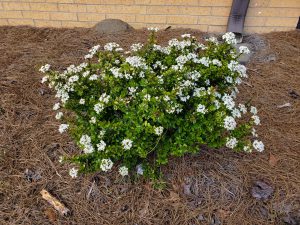
‘Whorled Class’ dwarf Walter’s Viburnum in a Calhoun County, FL landscape. Photo Credit: Daniel Leonard, University of Florida/IFAS Extension – Calhoun County.
Both the “wild-type” Walter’s Viburnum and the newer dwarf cultivars are about as low maintenance landscape shrubs as one could want. Though Walter’s normally occurs in shaded understory situations with moist, acidic soils in the wild, it is very adaptable to all manner of landscape situations. The species takes full sun extremely well but will also thrive with shade. It will tolerate very moist soil but, once established, is drought tolerant. I fertilize my Walter’s plants each spring with a general purpose, balanced garden fertilizer to boost growth, but there are many plantings of the species that get by without supplemental fertilizer. Finally, due to the dwarfing nature of the previously mentioned Walter’s cultivars, constant shearing won’t be necessary to maintain a pleasing shape, but they do respond well to pruning when a haircut is needed!
If you’ve been looking to include something a little bit different from the standard spring flowering fare in your landscape but also require your plants to be tough adaptable, try Walter’s Viburnum, especially the cultivars ‘Whorled Class’ or ‘Mrs. Schiller’s Delight’. They’ll be attractive, low-maintenance additions to nearly any Panhandle landscape for years to come! For more information about Walter’s Viburnum or any other horticultural or agricultural topic, contact your local UF/IFAS County Extension office. Happy gardening!















